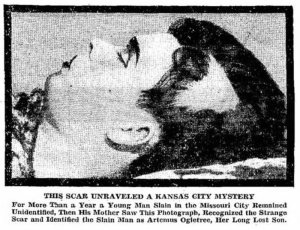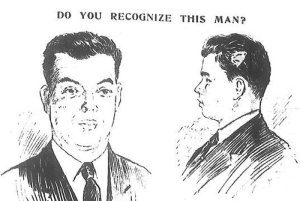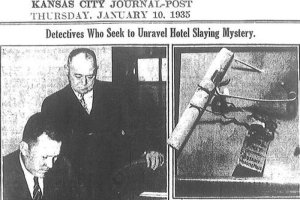KANSAS CITY, Mo. — A murder mystery from more than 80 years ago left behind a myriad of questions for detectives and historians today.
A man checked into a hotel in Kansas City with no luggage. He brought with him his toothbrush, toothpaste, and a comb. Some accounts report he also brought a brush.
 A few days later, someone murdered the man in a calculated fashion, leaving behind very few clues for detectives — besides some fingerprints on a phone stand, an unlit cigarette and some witness statements.
A few days later, someone murdered the man in a calculated fashion, leaving behind very few clues for detectives — besides some fingerprints on a phone stand, an unlit cigarette and some witness statements.
Oddities continued after the murder that added some flair to the investigation.
Multiple hotel staff members admitted they noticed strange things happening prior to the man’s death, but it took days before anyone took the unusual behavior seriously and brought it to the attention of a manager.
The internet has run wild with tales about this murder case. It’s been featured on Buzzfeed, Reddit and a plethora of blogs. Some of the details in these accounts vary radically, and some of the newspapers of the time had different spins on the case as well.
This happens in stories when several strange variables coexist and when the public takes an interest in its weirdness and spreads rumors. Some unsolved mysteries create their own lore.
Guest checks into hotel with hardly any personal belongings
On Wednesday, January 2, 1935, around 1:20 p.m. a man checked into the Hotel President under the name Roland T. Owen. The hotel is now called the Hilton President Kansas City. It’s located in the Power & Light District.
Witnesses told police he was around the age of 20-35 years old. Hotel statements agreed that the young man had brown hair and a visible scar on his scalp above his left ear. He had a cauliflower ear. A common condition for wrestlers and boxers.
Bellhop Randolph Propst described Owen on check-in day as a nicely dressed man in a black overcoat.
The bellhop accompanied Owen to his room, despite the guest having no luggage. When Owen checked into his room, he complained to Propst about the outlandishly high prices of a neighboring hotel, the Muehlebach.
After checking into the room, Owen left the hotel. During his stay, he would leave intermittently. It’s not clear where he would go or who he would visit. He likely spent time out in the bar scene.
Hotel maid has awkward interactions with guest
Hotel maid Mary Soptic talked to police after the murder and gave them an account of the previous days at the establishment.
“He was either worried about something or afraid,” she said to detectives.
“He always wanted to kind of keep in the dark,” she also noted.
Soptic stopped by room 1046 the same day he checked-in to clean it. A female guest had previously stayed in the room, and Soptic was surprised to find Owen.
The hotel maid noted in her statement to police that it was dimly lit and he kept the curtains tightly drawn. The only light came from a small, dim table lamp.
While she cleaned, Owen mentioned a friend was planning to visit him soon. He asked her not to lock the door while he was gone. She agreed as he left the room.
A few hours later, Soptic returned with fresh towels. The door was still unlocked from the previous encounter.
When she entered the room, she found Owen laying fully dressed on the still-made bed — she believed he was asleep.
A note on his bedside table read, “Don, I will be back in fifteen minutes. Wait.”
Possible Roland T. Owen sighting
City worker Robert Lane also reported a strange event that happened to him while driving down a street around 11:00pm the day Owen checked into the Hotel President.
Lane said a man wearing not enough clothes for January weather flagged him down and asked for a ride. Lane explained he wasn’t a taxi driver but a city worker. He agreed to take the man to a place to get a real taxi.
According to Lane, the man had a wound on his arm. He asked him about it.
The passenger nodded and swore revenge against “somebody” tomorrow.
The passenger was possibly Owen. Lane would later claim the victim mistook him for a taxi driver.
The second day at the hotel
On January 3, Soptic stopped by his room to make his bed. Owen’s door was locked from the outside, as it would be when guests leave. She opened the door with her master key.
It surprised her to find Owen sitting in a corner of the room in the dark. While the maid cleaned up the space, the phone rang. Owen hurried to answer it.
“No, Don. I don’t want to eat. I am not hungry. I just had breakfast,” he said. He repeated “No, I am not hungry.”
After the phone call, Owen complained again about the prices at the Muehlebach. He asked the maid a series of questions about her job and the hotel. He asked her how many rooms does she clean, what kind of people stay in the hotel, if anyone lived there, etc.
Soptic answered the questions, quickly finished cleaning, and left Owen alone in the room. It then dawned on her that someone had locked Owen into the room since the door was locked from the outside.
Later in the day, the maid returned with fresh towels. When she knocked on the door, she heard two male voices in the room.
She announced she had new towels, and a loud, deep voice (likely not Owen’s) told her to leave. He claimed there was enough towels. But Soptic had removed all the towels from the room in the morning. She knew there were no towels, at least from the hotel.
Soptic left the two men alone preferring not to intrude on the conversation.
On the same day, a woman reported hearing disturbing noises on the 10th floor.
Jean Owen (no relation to Roland) went to Kansas City to meet her boyfriend for the day. Instead of driving back to her hometown, she decided to stay at the Hotel President for the night. The hotel gave her the key to room 1048, right next door to 1046.
Police records indicate she heard repeated noise next door.
“I heard a lot of noise, which sounded like it [was] on the same floor and consisted largely of men and women talking loudly and cursing,” she said in her statement. “When the noise continued, I was about to call the desk clerk, but decided not to.”
Owen may have heard noise from a party happening that night in room 1055 and not room 1046.
An elevator operator, Charles Blocher, also reported after hours activity. A woman came into the hotel searching for a man in room 1026. He said she was about 135 pounds and 5-1/2 feet tall.
The woman searched for the man for well over an hour, and on different floors. She eventually left the premises. It’s possible she mistook room number 1046 for 1026. She had dark hair and was wearing a Black Hudson coat.
The violent scene in room 1046
The next morning, on January 4, the telephone operator noticed the phone in room 1046 was off the hook for the past 10 minutes without anyone using it. This was around 7 a.m.
Three hours later, the hotel sent bellhop Propst to check on Owen. The door to room 1046 was locked with a “do not disturb” sign hung on the doorknob.
The bellhop knocked on the door several times, and Owen told him he could enter; however, when the bellhop told Owen that the door was locked, Owen didn’t respond.
The bellhop knocked again, then yelled for Owen to hang up the phone, assuming Owen was drunk and had knocked it off the stand.
An hour and a half later, the telephone operator noticed the phone was still off the hook. The hotel sent bellhop Harold Pike to fix the problem. Pike used a passkey to get into the room.
Pike told police when he entered the room, Owen was laying naked on the bed, seemingly drunk. The bellhop noticed dark spots or substances in his bedclothes. Pike found the phone on the floor, and put it back on the hook. He locked the door behind him and reported Owen’s behavior to his manager.
About an hour later, the telephone operator called yet again. Room 1046’s phone was off the hook once more.
Around 11 a.m., bellhop Propst opened the door to the room to fix the phone problem — he walked into a blood-splattered room.
Owen was on his elbows and knees with his head in his hands. He was naked — his chest covered in stab wounds. His blood drenched the sheets and towels. The walls and ceiling had blood, too.
The hotel called police.
A mystery surfaces
Before crews took Owen to the hospital, a detective asked him about who else had been inside the room.
Owen responded, “Nobody.”

Owen wasn’t fully conscious and was struggling to talk. He told the detective he “fell against a bathtub.”
While at the hospital, doctors deduced someone had tortured the hotel guest.
It appeared someone restrained Owen’s arms, legs, and neck with cords. His chest sustained multiple stab wounds, he had a punctured lung, and a fractured skull. Someone had hit his head repeatedly.
Roland T. Owen died at the hospital shortly after arriving there.
The doctors said the injuries to his body took place 6-7 hours ago, meaning the attack happened before bellhop Propst’s first trip to Owen’s room in the morning.
Detectives suspected the patron tried to call for help multiple times, but hadn’t been able to make it past picking up the phone due to his severe injuries.
When investigators searched the room, more questions surfaced than answers.
Not a single piece of clothing was found in 1046. The space lacked the standard hotel amenities. There were no shampoo bottles, towels and the like.
Police found an unlit cigarette, a label from a tie, and four fingerprints — likely from a female — on the phone stand. Detectives quickly ruled out suicide as a possibility.
While checking into the hospital, Owen mentioned he was from Los Angeles. Authorities couldn’t find a record matching his name.
The big twist: detectives found that Roland T. Owen never existed.
He used an alias when he checked into the establishment. There was no record of such a man having lived anywhere in the United States. Police implored the public to come forward with any information they had about the victim.
Investigation trail leads nowhere
Shortly after the murder, the neighboring hotel that Owen had complained about frequently, came forward, claiming a man matching the description stayed at the hotel on January 1.
He had checked into the rest stop under the name Eugene K. Scott — another alias with no existing record.
He’s also suspected of using the names Duncan Ogletree and Cecil Werner, according to his memorial grave listing online.
Over the next couple of months, people reached out to Kansas City authorities to see if the victim might be their missing loved one, but none of their identifications stuck.

Police focused on the mysterious Don who the victim had referred to in his note. It’s not clear whether Don was a male friend, a nickname for Donna, or a title for someone in the mafia business. The mafia was prolific at this time.
Police never figured out who was Don.
The case ran cold before he could be buried. The Kansas City Journal-Post reported Owen was to be buried in a potter’s field on March 3rd.
An anonymous person called the funeral home in charge of the victim’s burial service and said they would provide money for Owen to have a proper funeral.
On March 23, money bundled in a newspaper arrived at the funeral home from an anonymous sender. Someone sent funeral flowers anonymously arranged through Rock Flower Company along with a card that said: “Love forever, Louise.”
Possible son of Ruby Ogletree
About a year and a half later, in 1936, a friend of Ruby Ogletree found an American Weekly piece chronicling the Owen case.
Ogletree looked at it and identified Owen as her son who left his home in Birmingham, Alabama in 1934. She claimed his name was Artemus Ogletree. Oddly enough, his name is an anagram for: a gruesome letter.
Police eventually believed her and the Ogletree family — one family member identified the scar on his head as a childhood accident caused by hot grease.
The man’s online grave listing is in Memorial Park in Kansas City and under the name Artemus Ogletree. He would have only been 17 years old at the time of the attack.
Ruby Ogletree said she received several letters from her son in the spring of 1935. Someone likely wrote and mailed the letters after the hotel guest’s death. Ogletree wasn’t sure her son actually knew how to type. She also found the tone of the writing didn’t match her son’s style.
Ogletree said she received a call in August of 1935 from a man in Memphis, Shelby County, Tennessee. He advised her that her son was in Cairo, Egypt unable to write because he had lost his thumb in a fight in which he saved the caller’s life.
Ogletree said the caller “talked wildly.” She noted he did, however, seem to have knowledge about her son.
After investigators checked with steamship and consular authorities in Cairo, they failed to trace the young Artemus. The case was reported to J. Edgar Hoover, the head of the newly founded FBI.
Decades later and no real answers
In 2003, Dr. John Horner wrote a lengthy account on the murder cased published by the Kansas City Public Library. He received an out-of-state call about Artemus Ogletree.
The caller claimed to find a box with newspaper articles about the Ogletree murder. It was found in a deceased elderly person’s belongings. The caller said there was also an item found in the box and the articles had referred to it several times — but the caller didn’t specify what was the item.
Almost 85 years later, the case remains unsolved. Kansas City police open the case and add new information and evidence when available. He was the first of 74 murder victims in Kansas City that year and one of 16 that wasn’t solved by the end of the year.

According to his grave listing on Find a Grave, known law enforcement officials who worked on this case after the murder included: J Edgar Hoover, Director of the FBI; Detective Chief Thomas J. Higgins; Detective Sgt. Frank Howland; and Police Chief Luther Hollums.
Some of the big questions that remain: Who was Don? Why did someone anonymously pay for Ogletree’s funeral? Why was the guest using alias names? Who was behind the Louise note? Did the hotel guest have ties to the mafia?
